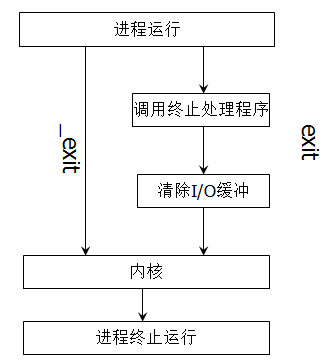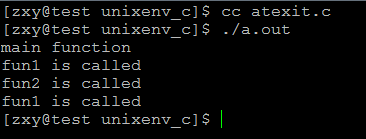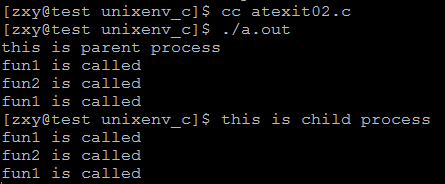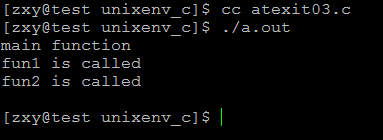一,程式終止有5種方式:
正常退出:
- 從main函式返回
- 呼叫exit
- 呼叫_exit
異常退出:
- 呼叫abort
- 由訊號終止
二,exit和_exit區別:
關於_exit():
#include <unistd.h>
void _exit(int status);
#include <stdlib.h>
void _Exit(int status);
DESCRIPTION
The function _exit() terminates the calling process "immediately". Any
open file descriptors belonging to the process are closed; any children
of the process are inherited by process 1, init, and the process’s par-
ent is sent a SIGCHLD signal.
The value status is returned to the parent process as the process’s
exit status, and can be collected using one of the wait(2) family of
calls.
The function _Exit() is equivalent to _exit().
關於exit():
#include <stdlib.h>
void exit(int status);
DESCRIPTION
The exit() function causes normal process termination and the value of
status & 0377 is returned to the parent (see wait(2)).
All functions registered with atexit(3) and on_exit(3) are called, in
the reverse order of their registration. (It is possible for one of
these functions to use atexit(3) or on_exit(3) to register an addi-
tional function to be executed during exit processing; the new regis-
tration is added to the front of the list of functions that remain to
be called.) If one of these functions does not return (e.g., it calls
_exit(2), or kills itself with a signal), then none of the remaining
functions is called, and further exit processing (in particular, flush-
ing of stdio(3) streams) is abandoned. If a function has been regis-
tered multiple times using atexit(3) or on_exit(3), then it is called
as many times as it was registered.
All open stdio(3) streams are flushed and closed. Files created by
tmpfile(3) are removed.
The C standard specifies two constants, EXIT_SUCCESS and EXIT_FAILURE,
that may be passed to exit() to indicate successful or unsuccessful
termination, respectively.
和exit比較一下,exit()函式定義在stdlib.h中,而_exit()定義在unistd.h中,
注:exit()就是退出,傳入的引數是程式退出時的狀態碼,0表示正常退出,其他表示非正常退出,一般都用-1或者1,標準C裡有EXIT_SUCCESS和EXIT_FAILURE兩個巨集,用exit(EXIT_SUCCESS);
_exit()函式的作用最為簡單:直接使程式停止執行,清除其使用的記憶體空間,並銷燬其在核心中的各種資料結構;exit() 函式則在這些基礎上作了一些包裝,在執行退出之前加了若干道工序。
exit()函式與_exit()函式最大的區別就在於exit()函式在呼叫exit系統呼叫之前要檢查檔案的開啟情況,把檔案緩衝區中的內容寫回檔案,就是"清理I/O緩衝"。
exit()在結束呼叫它的程式之前,要進行如下步驟:
1.呼叫atexit()註冊的函式(出口函式);按ATEXIT註冊時相反的順序呼叫所有由它註冊的函式,這使得我們可以指定在程式終止時執行自己的清理動作.例如,儲存程式狀態資訊於某個檔案,解開對共享資料庫上的鎖等.
2.cleanup();關閉所有開啟的流,這將導致寫所有被緩衝的輸出,刪除用TMPFILE函式建立的所有臨時檔案.
3.最後呼叫_exit()函式終止程式。
_exit做3件事(man):
1,Any open file descriptors belonging to the process are closed
2,any children of the process are inherited by process 1, init
3,the process's parent is sent a SIGCHLD signal
exit執行完清理工作後就呼叫_exit來終止程式。
三,atexit()
atexit可以註冊終止處理程式,ANSI C規定最多可以註冊32個終止處理程式。
終止處理程式的呼叫與註冊次序相反
#include <stdlib.h>
int atexit(void (*function)(void));
DESCRIPTION
The atexit() function registers the given function to be called at nor-
mal process termination, either via exit(3) or via return from the pro-
gram’s main(). Functions so registered are called in the reverse order
of their registration; no arguments are passed.
The same function may be registered multiple times: it is called once
for each registration.
POSIX.1-2001 requires that an implementation allow at least ATEXIT_MAX
(32) such functions to be registered. The actual limit supported by an
implementation can be obtained using sysconf(3).
When a child process is created via fork(2), it inherits copies of its
parent’s registrations. Upon a successful call to one of the exec(3)
functions, all registrations are removed.
RETURN VALUE
The atexit() function returns the value 0 if successful; otherwise it
returns a non-zero value.
示例程式:
#include <stdio.h> #include <unistd.h> #include <stdlib.h> void fun1() { printf("fun1 is called\n"); } void fun2() { printf("fun2 is called\n"); } int main(void) { printf("main function\n"); atexit(fun1); atexit(fun2); atexit(fun1); exit(EXIT_SUCCESS); }
執行結果:
當呼叫fork時,子程式繼承父程式註冊的atexit:
示例程式:
#include <stdio.h> #include <unistd.h> #include <stdlib.h> #define ERR_EXIT(m) \ do\ {\ perror(m);\ exit(EXIT_FAILURE);\ }\ while (0)\ void fun1() { printf("fun1 is called\n"); } void fun2() { printf("fun2 is called\n"); } int main(void) { pid_t pid; pid = fork(); atexit(fun1); atexit(fun2); atexit(fun1); if(pid == -1) ERR_EXIT("fork error"); if(pid == 0){ printf("this is child process\n"); } if(pid > 0){ printf("this is parent process\n"); } return 0; }
執行結果:
當atexit註冊的函式中有一個沒有正常返回或被kill,則後續的註冊函式都不會被執行
示例程式:
#include <stdio.h> #include <unistd.h> #include <stdlib.h> #include <signal.h> void fun1() { printf("fun1 is called\n"); } void fun2() { printf("fun2 is called\n"); kill(getpid(),SIGINT); } int main(void) { printf("main function\n"); if(signal(SIGINT,SIG_DFL) == SIG_ERR){ perror("signal error"); exit(EXIT_FAILURE); } atexit(fun1); atexit(fun2); atexit(fun1); exit(EXIT_SUCCESS); }
執行結果:
可見最後那個fun1沒有執行



